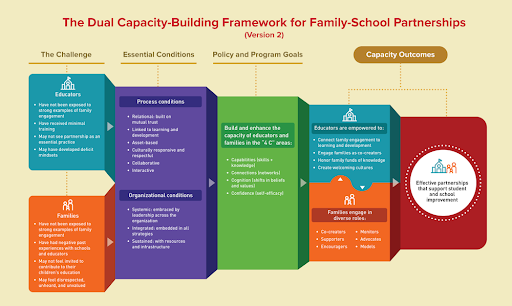
By Heather Ippolito, Vice President for Family Engagement , California State PTA
Whose job is it to create partnerships between families and the schools that serve them? That question has driven the work of Dr. Karen Mapp, a Harvard professor and a contributing expert to the PTA National Standards for Family-School Partnerships that we have been sharing over the past few months.
At a really basic level, her answer to that question is that both school personnel and family members are crucial to making the partnership work.
Dr. Mapp has spent her career working with educators and parents to cultivate partnerships between schools, families, and the community to support the best outcomes for our students. In 2019 she updated her Dual-Capacity Framework to better reflect the challenges faced by both educators and families and to give more direction on how we can work together in our schools.

The framework contains four sections. Addressing all four can provide crucial support for strong family, school and community partnerships. Let’s go through each section briefly:
#1 – Challenges. Dr. Mapp notes that before we talk about all the things that need to happen for successful partnerships we need to address the barriers and challenges that schools and parents face for family engagement.
Barriers educators face include not having received much training in this area and, with the exception of very few, not seeing family engagement done well. Parents’ challenges include not feeling welcomed on campus or having negative experiences with their own education that color their feelings towards a school setting.
#2 – Essential Conditions. There are two different types of essential conditions; process and organizational conditions.
Process conditions include things like having family engagement linked to student learning and making sure it is culturally responsive. Additionally, Dr. Mapp says that in the process category family engagement should be collaborative and interactive with a focus on building relationships. The organizational conditions that need to be met include family engagement being visible across the entire educational system — meaning that family engagement needs to be supported by everyone from teachers to superintendents in order to be effective. There must also be resources devoted to the program and it should be embedded in all aspects of education.
#3 – Policy and Program Goals. There are “4 C” areas that Dr. Mapp feels must be met in the policy and program areas- Capabilities, Connections, Confidence, and Cognition.
Capabilities include skills and knowledge. Schools need to understand the community they are working in and they need cultural competencies to be able to work with the families at their school. Parents need to have a better understanding of the educational system and strategies they can use at home to support learning.
Connections are the important relationships and networks built on mutual trust and respect that need to be formed between parents and teachers, parents and parents, and the school and community.
Both families and educators need confidence in working together. They need to have time to develop self-efficacy as they navigate this work and educators and parents of diverse backgrounds need to be encouraged to participate and be included in positions of leadership.
Finally, cognition refers to families needing to see themselves as key partners in their child’s educational success. Schools need to be committed to working with all parents and see the value of including families in all aspects of the educational experience.
#4 – Capacity Outcomes. If we build up the capacity in our parents and educators then the real work of coming together to make improvements for our schools and our students can begin. Parents become supporters, advocates and co-creators at the school and educators create welcoming school cultures where families are encouraged to be co-creators and acknowledged for the skills and talents they bring to the campus.
Our role as PTA leaders is to understand that schools and families need to work together. We can use the Dual Capacity-Building Framework in our work with families and we can offer parent education to help parents understand how to navigate the education system or see how they can support their child at home. PTA programs can help to shift parents’ perspectives about school from negative to positive as we help them create positive interactions with teachers, administrators, and school staff at our events.
To learn more about National PTA’s Transformative Family Engagement work, visit the Center for Family Engagement.
Dr. Mapp, in collaboration with the Institute for Educational Leadership, has videos, graphics and lots of resources for anyone who is wanting to dive deeper into this. They can be accessed here: https://www.dualcapacity.org/ .